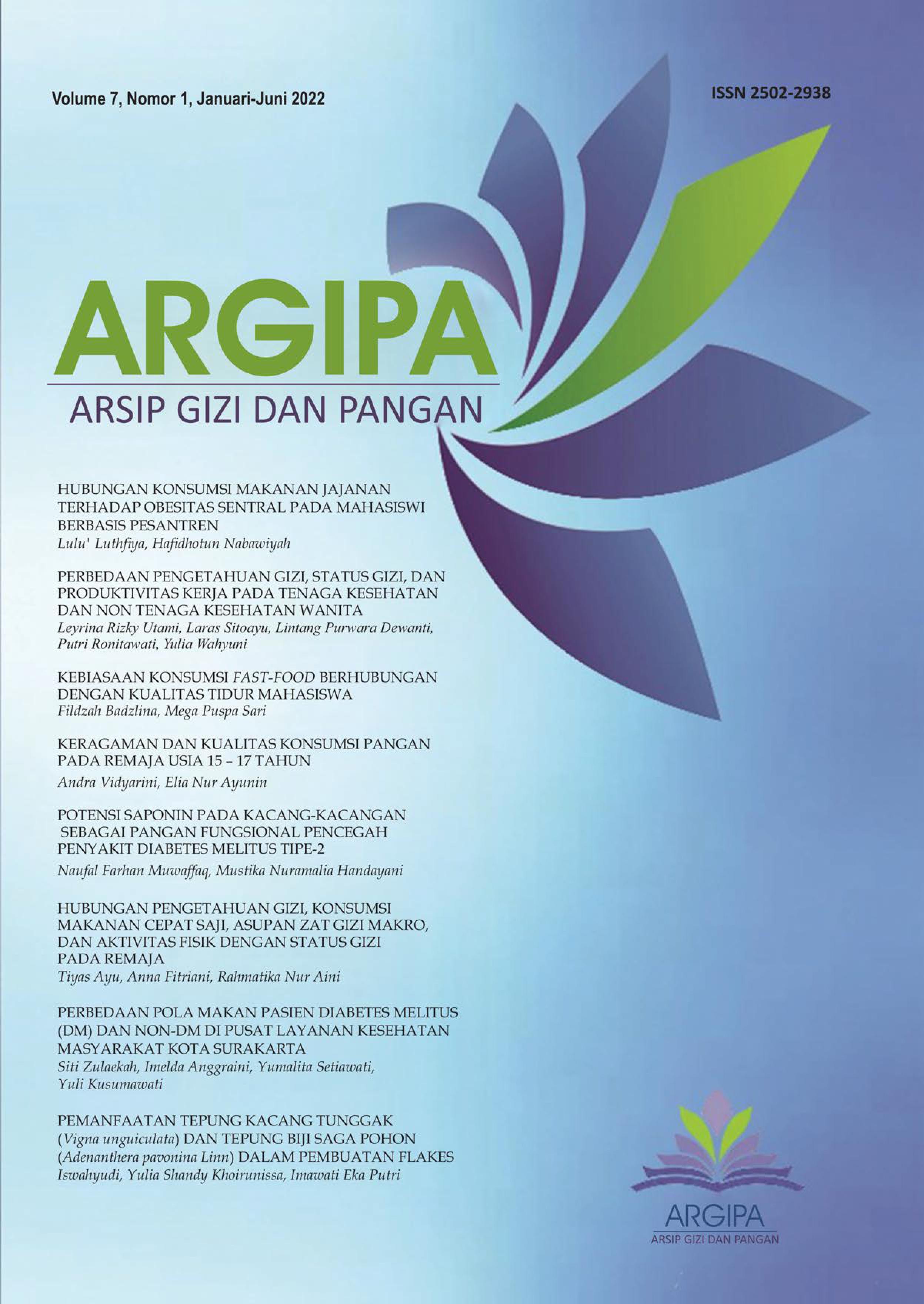Potential of saponin in nuts as a functional food for preventing Type-2 Diabetes Mellitus
DOI:
https://doi.org/10.22236/argipa.v7i1.8000Keywords:
Type-2 Diabetes Mellitus, Saponin, NutsAbstract
Type 2 Diabetes Mellitus is a chronic disease that cannot be cured but has the potential to be prevented and controlled. Diabetes is the 9th leading cause of death in the world. The management of Type-2 Diabetes Mellitus can be done non-pharmacologically using natural compounds, one of which is saponins obtained from nuts. Saponins acts as inhibitors of the activity of the α-glucosidase enzyme which functions to convert carbohydrates into glucose so that glucose absorbed by the small intestine can be blocked. This study aims to determine the potential of saponins from nuts. This research method is literature study of 78 articles and filtered about 15 articles with the keywords saponin content in nuts. The results of this study prove that there is potential for saponins found in nuts and the greatest potential for saponins is found in soybeans (glycine max), navy beans (phaseolus vulgaris), and red beans (phaseolus vulgaris).
Downloads
References
American Diabetes Association. (2014). Diagnosis and classification of diabetes mellitus. Diabetes Care.37 Suppl 1:S81–S90.
American Diabetes Association. (2017). Classification and Diagnosis of Diabetes. Diabetes Care. 40 Suppl 1:S11–S24.
Badan Pengawas Obat dan Makanan Republik Indonesia. (2011). Peraturan Kepala Badan Pengawas Obat Dan Makanan Republik Indonesia Nomor Hk.03.1.23.11.11.09909 Tahun 2011 Tentang Pengawasan Klaim Dalam Label Dan Iklan Pangan Olahan.
Becerra-Tomás, N., Díaz-López, A., Rosique-Esteban, N., Ros, E., Buil-Cosiales, P., Corella, D., Estruch, R., Fitó, M., Serra-Majem, L., Arós, F., Lamuela-Raventós, R. M., Fiol, M., Santos-Lozano, J. M., Díez-Espino, J., Portoles, O., Salas-Salvadó, J., Serra-Mir, M., Pérez-Heras, A., Viñas, C., . . . Timiraus-Fernández, J. (2018). Legume consumption is inversely associated with type 2 diabetes incidence in adults: A prospective assessment from the PREDIMED study. Clinical Nutrition, 37(3), 906–913.
Chai, Y., Luo, J., & Bao, Y. (2021). Effects of Polygonatum sibiricum saponin on hyperglycemia, gut microbiota composition and metabolic profiles in type 2 diabetes mice. Biomedicine & Pharmacotherapy, 143, 112155.
Choi, M. R., Kwak, S. M., Bang, S. H., Jeong, J. E., & Kim, D. J. (2017). Chronic saponin treatment attenuates damage to the pancreas in chronic alcohol-treated diabetic rats. Journal of Ginseng Research, 41(4), 503–512.
Curl, C.L., Price, K.R. & Fenwick , G.R. (I 98 5) : The quantitative estimation of saponin in pea (pisum sativum L.) and soya (Glycine max). Food Chem. 18, 24 1-250.
Deokate U.A. and Khadabadi S., 2012, Pharmacology and Phytochemistry of Coccinia Indica. An International Research Journal, 3 (3), 179–185.
Fiana N, Oktaria D. 2016. Pengaruh Kandungan Saponin Dalam Daging Buah Mahkota Dewa (Phaleria macrocorpa) Terhadap Penurunan Kadar Gula Darah. Majority vol 5 (4).
Hostettmann K, Marston A (1995) Saponins. Cambridge University Press, Cambridge.
Ireland, P.A . & Dzeidzic, S.Z. (1985) : Analysis of sapogenins in soybean by high performance liquid chromatography. J. Chroma togr. 235, 275 -279 .
Jiang, S., Xu, L., Xu, Y., Guo, Y., Wei, L., Li, X., & Song, W. (2020). Antidiabetic effect of Momordica charantia saponins in rats induced by high-fat diet combined with STZ. Electronic Journal of Biotechnology, 43, 41–47.
Kitagawa , 1. , Yoshikawa, M., Hayashi, T . & Tanayama, T . (1984a). Characteri sation of saponin constituents in soybeans of various origins and quantitative analysis of soyasaponins by gas-liquid chromatography. Yakugaku Zasshi 104, 162-168.
Kusharto, C. M. 2006. Dietary Fiber and Its Role for Health. J. Gizi dan Pangan : 1(2), 45-54.
Luo, J., Chai, Y., Zhao, M., Guo, Q., & Bao, Y. (2020). Hypoglycemic effects and modulation of gut microbiota of diabetic mice by saponin from Polygonatum sibiricum. Food & Function, 11(5), 4327–4338.
Moreno-Valdespino, C. A., Luna-Vital, D., Camacho-Ruiz, R. M., & Mojica, L. (2020). Bioactive proteins and phytochemicals from legumes: Mechanisms of action preventing obesity and type-2 diabetes. Food Research International, 130, 108905.
Paul, A.A. & Southgate , D.A.I. (1978). McCance and Widdowson's 'The composition of Foods', 4th edn., Special Report 297, London : Her Maj estey's Stationery Office.
Price, K.R., Curl, C.L. & Fenwick, G.R. (1986). The saponin content and sapogenol composition of the seed of 13 varieties of legume. J. Sci. Food Agric. 37, I 185-1191.
Prisma, E. Efek Hipoglikemik Influsa Simplisia Daging Mahkota Dewa (Phaleria Macrocarpa (Scheff). Boerl) pada Tikus Jantan Putih (Skripsi). Yogyakarta : Fakultas Kedokteran Universitas Gajah Mada ; 2002.
Ridout, C. L., Wharf, S. G., Price, K., Johnson, I., & Fenwick, G. (1988). Uk Mean Daily Intakes of Saponins-Intestine-Permeabilizing Factors in Legumes. Food Sciences and Nutrition, 42(2), 111–116.
Sparg, S.G., M.E. Light, & J. van Staden. 2004. Biological activities and distribution of plant saponins. J. Ethnopharmacol. 94: 219–243.
Suarni & Yasin, 2011. Jagung Sebagai Sumber Pangan Fungsional. Iptek Tanaman Pangan, Vol. 6 No. 1 Mei 2011. Pusat Penelitian dan Pengembangan Tanaman Pangan. Badan Litbang Pertanian.
Tan, S.P., Wenlock, R.W. & Buss,D.H. (1985). Immigrant foods. Secondsupplement to McCance and Widdowson's 'The composition of foods', London: Her Majesty's Stationery Office.
Wang, Q., Wu, X., Shi, F., & Liu, Y. (2019). Comparison of antidiabetic effects of saponins and polysaccharides from Momordica charantia L. in STZ-induced type 2 diabetic mice. Biomedicine & Pharmacotherapy, 109, 744–750.
WHO.int (2021, 13 April). Diabetes. Diakses pada 1 November 2021, dari https://www.who.int/news-room/fact-sheets/detail/diabetes.
Zheng, T., Shu, G., Yang, Z., Mo, S., Zhao, Y., & Mei, Z. (2012). Antidiabetic effect of total saponins from Entada phaseoloides (L.) Merr. in type 2 diabetic rats. Journal of Ethnopharmacology, 139(3), 814–821.

















